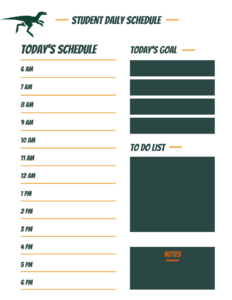In college, you have the complete freedom of choosing the classes you take at the time that works best for you. Building a class schedule that works well with your personal and professional life is the ultimate key to a successful college career. You want to make sure you’re adding time blocks in, so you’re not overwhelmed with coursework, homework, and extracurricular activities. Here’s how to build the best class schedule to help you succeed in college. Our secret? Time management!
Considerations When Building Your Schedule
 1. Credit Hours Required for Your Degree
1. Credit Hours Required for Your Degree
When building your schedule, consider the number of credit hours you want to take for each semester. Are you a part-time student or a full-time student? You can take up to 15 credit hours each semester depending on your college’s policy. Most colleges split the 30 credit hours a year into 12 credits in both the fall and spring semesters. The remaining 6 credits are usually taken over the summer.

2. Consider When You are most Productive
Start with the classes that are prerequisites to your more advanced courses later on in your college career. You’ll get these general education classes out of the way and create a strong foundation for the harder ones the following semester. Classes can start early in the morning, mid-day, and in the evening. If you’re a true early riser, you can take your classes in the morning and mid-day so you can have the rest of your time to study or work. If you prefer to sleep in and enjoy your slower mornings, you can take mid-day and evening classes.
It’s important to be honest with yourself about which part of the day you feel most productive. If you’re not someone who easily commits to morning plans, taking an 8 AM class will not be beneficial for you. You may actually end up skipping classes if you don’t consider your productive hours when creating your class schedule.
3. Work Hours if Employed
Another important factor when building your class schedule is your work hours if you’re employed. A majority of college students have part-time jobs while some even have full-time jobs. While having a job and juggling college classes can be difficult, creating a class schedule that aligns together will make doing both so much easier. If your job allows you to work evening hours, you should take morning and mid-day classes. If your job prefers you to work morning hours, you should take mid-day and evening classes. You can even take online classes so you can work more hours and do the schoolwork on your own time.
4. Extracurricular Activities Schedules
Beefing up your resume throughout college is the perfect way to get more noticed during job interviews after you graduate. But how do you do that? Joining clubs, playing sports, being on committees, and becoming a TA in college is a great way to do so. Find the time in your class schedule to attend all the meetings and games with proper preparation. Going to college isn’t just about the coursework so get involved more when your schedule is planned out with intention.
Steps to Building Your Class Schedule
1. Meet with an Academic Advisor
It’s easy to find the necessary credits you need to graduate for your particular degree. Whether you’re a microbiology, criminology, or education major, the entire course catalog will be available online for you to view. You should make an appointment with your academic advisor before you pick your classes for the following semester. They can help you build a schedule that will keep you on track to graduate within your desired timeline. Some people take 3 years to graduate while others can take 5 years. Speaking with an advisor will eliminate the guesswork so you’re confident in your course schedule.
2. Use an Online Schedule Builder
While building your schedule for college, you can add all your desired courses to your online cart (depending on your college), and it will show your future schedule. You can see which days you’ll have certain classes and it’ll be organized for you. An online schedule maker for college is super convenient and available at most schools.
3. Make Time for Breaks
Once you have your classes picked out for the semester, make sure you have enough time between each class to get from one side of the campus to another. Factor in lunches, snacks, parking, and bathroom breaks in between your college courses so you’re not in a rush. To help you visualize your daily schedule, getting a weekly or monthly planner is a great idea. You can even use a timetable to prevent overlaps!
The “best” class schedule looks different for each college student.
Some students have the capacity to take 3 classes a day a few times a week. Some students only have the capacity to take one or two classes a day. Consider how much you can take on while still in good standing with your mental and physical health.





